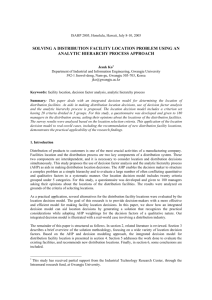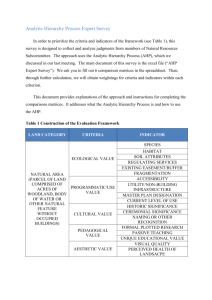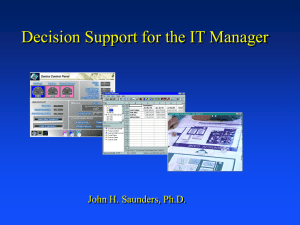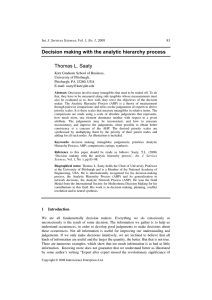Note STAFFING ELECTRIC STRATEGIC
advertisement
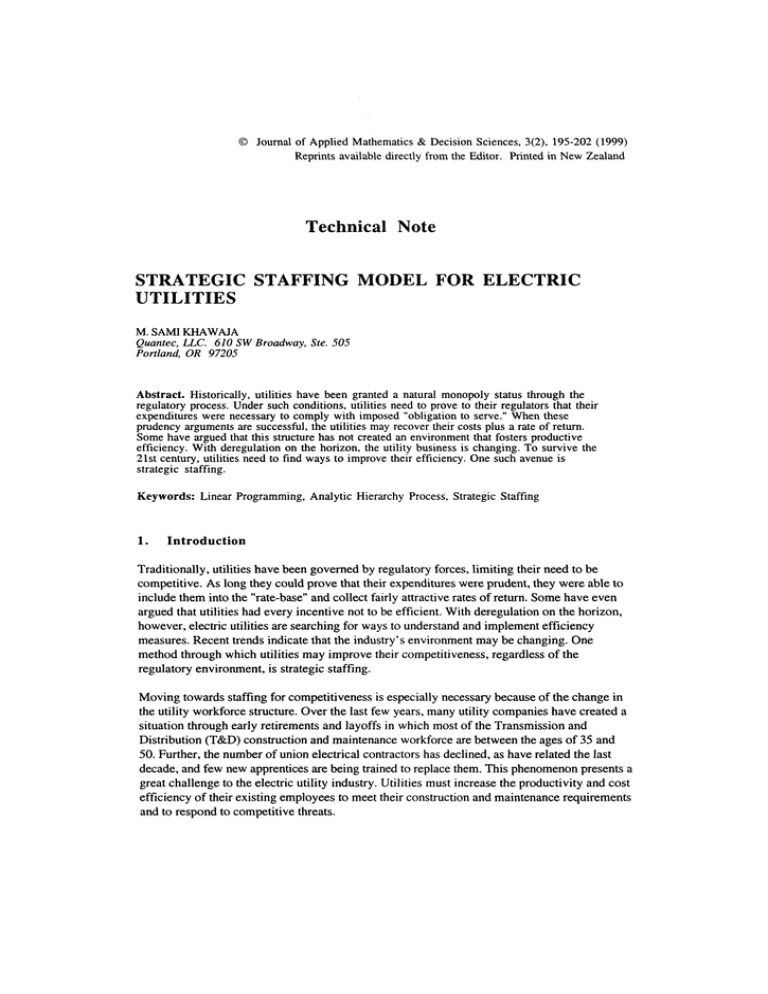
& Decision Sciences, 3(2), 195-202 (1999) Reprints available directly from the Editor. Printed in New Zealand (C) Journal of Applied Mathematics Technical Note STRATEGIC STAFFING MODEL FOR ELECTRIC UTILITIES M. SAMI KHAWAJA Quantec, LLC. 610 SW Broadway, Ste. 505 Portland, OR 97205 Abstract. Historically, utilities have been granted a natural monopoly status through the regulatory process. Under such conditions, utilities need to prove to their regulators that their expenditures were necessary to comply with imposed "obligation to serve." When these prudency arguments are successful, the utilities may recover their costs plus a rate of return. Some have argued that this structure has not created an environment that fosters productive efficiency. With deregulation on the horizon, the utility business is changing. To survive the 21st century, utilities need to find ways to improve their efficiency. One such avenue is strategic staffing. Keywords: Linear Programming, Analytic Hierarchy Process, Strategic Staffing 1. Introduction Traditionally, utilities have been governed by regulatory forces, limiting their need to be competitive. As long they could prove that their expenditures were prudent, they were able to include them into the "rate-base" and collect fairly attractive rates of return. Some have even argued that utilities had every incentive not to be efficient. With deregulation on the horizon, however, electric utilities are searching for ways to understand and implement efficiency measures. Recent trends indicate that the industry’ s environment may be changing. One method through which utilities may improve their competitiveness, regardless of the regulatory environment, is strategic staffing. Moving towards staffing for competitiveness is especially necessary because of the change in the utility workforce structure. Over the last few years, many utility companies have created a situation through early retirements and layoffs in which most of the Transmission and Distribution (T&D) construction and maintenance workforce are between the ages of 35 and 50. Further, the number of union electrical contractors has declined, as have related the last decade, and few new apprentices are being trained to replace them. This phenomenon presents a great challenge to the electric utility industry. Utilities must increase the productivity and cost efficiency of their existing employees to meet their construction and maintenance requirements and to respond to competitive threats. M. Sami Khawaja 196 Improved scheduling and work planning are essential. The ability to effectively decide how to enhance a company’s workforce does not depend solely on cost analyses. Many intangibles, subjective, and qualitative factors go into the decision. Our model attempts to optimize T&D labor allocation by examining various scenarios in different states occurring over the next ten years. We chose a combination of mathematical optimization and the Analytic Hierarchy Process. Our data included several elements that could easily be incorporated into a linear programming framework. However, there were several intangible issues that needed to be incorporated. We used the Analytic Hierarchy Process to model the appropriate linear programming constraints associated with such intangibles. 2. MODELING APPROACH The T&D labor optimization model has three components: (1) a forecasting model; (2) an analytic hierarchy process model; and (3) a linear programming model. Figure displays the overall model. Our approach involved initially separating the problem into two components: quantitative and qualitative. The quantitative component was directly dealt with through the linear programming model. The qualitative component was handled via a modeling approach called the analytic hierarchy process (AHP). The following sections describe each of the models briefly. 2.1 Forecasting Model Our approach starts with a model used to forecast pole miles. The main inputs are the company’s MWh demand forecast divided by different customer sectors (residential, commercial, and industrial) for different states. Pole mile forecasts were converted to gross labor demand forecasts based on historical labor utilization rates. This series of forecasts included three sets of line activity (distribution construction, distribution operations and maintenance, and transmission and substation construction) for each of nine states/regions. The forecasts are based on methods that were deemed most appropriate for each line type. For example, construction of the distribution system is based on an econometric model because this type of activity is related to customer base growth. The distribution operations and maintenance forecast is based on a series of loading factors applied to the distribution construction forecast. The transmission and substation construction forecast is based on engineering estimates because this activity is best characterized by discrete projects and is not generally modeled using an econometric approach. STRATEGIC STAFFING MODEL FOR ELECTRIC UTILITIES 197 2.2 Analytic Hierarchy Model We employ a relatively new approach called the analytic hierarchy process (AHP) in our analysis. (Saaty 1980) We used the AHP in the framework proposed by Armacost and Hosseini (1994) and Javalgi et. al. (1989) In this study, the AHP was used to first evaluate how subjective criteria (e.g., service, reliability, quality, etc.) affect the choice between in-house and contract labor. The results of the analysis included a set of importance weights for the criteria (and, if applicable, subcriteria) and preference weights for the in-house crew and contractors choices. AHP involves three basic elements: (1) it describes a complex, multicriteria problem with objective or subjective elements as a hierarchy; (2) it estimates the relative weights of importance for various criteria (or subcriteria) on each level of the hierarchy; and (3) it integrates these relative weights to develop an evaluation of the hierarchy with respect to the problem’s overall objectives. (Saaty 1980 and 1986) With the use of the to 9 ratio scale, the respondents can assess and establish the dominance of one component over the others with respect to each component of the next immediately higher level of the hierarchy. In general, if the hierarchy includes n criteria, a total of n (n-1)/2 comparisons are possible because each element in the diagonal is 1, representing the comparison of each criterion (or alternative) to itself, and the elements in the lower triangle (aj) are reciprocals of their corresponding upper triangle elements (%). In this ratio scale format, if the preference for criterion relative to criterion 2 is 7, then the preference for criterion 2 relative to criterion is 1/7, the reciprocal of 7. (For a discussion that justifies the use of the reciprocal ProPerty, see Saaty 1980.) AHP offers considerable flexibility in the structuring of hierarchical choice theory with the use of a nine-point scale, reciprocal matrices, and the establishment of ratio scale estimates through the solving of eigenvalue problems. When a group uses AHP, its judgments can be combined by applying the geometric mean to the judgments. AHP is similar to other widely used statistical tools such as conjoint analysis. It also has some similarity to decision trees in the sense that AHP helps construct the problem into a logical structure showing various options and the associated payoffs. AHP uses pairwise comparisons to estimate the relative importance of specific criteria within each hierarchy level. AHP also provides a means of assessing the consistency of respondents’ judgments with respect to their evaluations. For example, if respondents believe that A is more important than B and B is more important than C, they must believe that A is more important than C. Furthermore, if A is more important than B with a scale of 3 and B is also more important than C with a scale of 3, then A must be more important than C by with a scale of 9. The AHP’s consistency analysis quantifies this concept and provides a means for assessing overall consistency. A measure ranging between 0 and is called the "inconsistency M. Sami Khawaja 19 8 ratio." Empirically, if the inconsistency ratio is more than 0.10 (Saaty 1980), the overall consistency is unacceptable. In this case, a technique identifies the most inconsistent judgments and either eliminates or adjusts them. Inconsistencies (aijajk aik) are a fact of life and are difficult to deal with in a rational manner. The consistency of the matrix can be determined by comparing the consistency index (C.I.) with the average random consistency index (R.I.). In other words, by using a reciprocal matrix, the consistency index is compared with what it would be if the numerical judgments were taken at random from the scale 1/9, 1/8, 1/7 9. Using simulation, Saaty (1980) has established an average 1/2, 1, 2 consistency index for different order random-entry reciprocal matrices. Finally, the manager is asked to indicate the effectiveness level of in-house versus contract labor in each of the subcriteria presented. The process is repeated for the other criteria (i.e., for reliability and outage restoration, managers are asked to assess the importance of "response time," "ability to switch subs and lines," "productivity," and so on, and further show preference for in-house versus contractors for each of the subcriteria). A survey was prepared and submitted to key experts within PacifiCorp. Their inputs were solicited regarding the various qualitative variables having an impact on T&D labor allocation. These responses were analyzed using an AI-IP software program called Expert ChoiceTM. Expert ChoiceTM produced outputs consisting of weights that were directly input into the linear programming portion of the model. These weights served as ratios of the in-house to contractor crews over the next ten years. Managers’ preferences for in-house ranged from a low of 0.435 to a high of 0.522, indicating that managers preferred to keep the in-house to a total ratio at no less than 43.5%. This was the lower limit imposed on the linear programming model. 2.3 Linear Programming Model The linear programming model combines input from the forecasting model, the AHP assessment of qualitative issues, and other accounting inputs to determine the optimal mix of in-house versus contracted labor over the next ten years. The model was run with both the quantitative and the AHP-driven qualitative constraints. It provided estimates of full-time equivalence (FTE) requirements and mix (linemen versus foremen, contract versus in-house, regular time versus overtime, etc.) by the states over the study period. 3. FINDINGS The model recommended that the in-house labor supply be maintained at a stable level over the study period (near 38% to 40% of total labor). In-house overtime needs to be maximized. Contract labor needs to be used to meet short-term needs. The model produced forecasts that STRATEGIC STAFFING MODEL FOR ELECTRIC UTILITIES 199 should help PacifiCorp determine when these needs will arise and will help them be prepared to meet them. Figure 1- Overall Model A’na’ytp rCocH’e rsarC" Econometric Forecast i Linear Programming Optimal Solution 4. SENSITIVITY ANALYSIS We built the model while maintaining some level of healthy scepticism about the various input values, and we viewed them as starting points for further analysis of the problem. An optimal solution is only optimal with respect to the specific values of parameters. It only becomes a reliable guide after it has proven its robustness or lack of sensitivity to varying values of the input parameters. In other words, models are useful when they have been verified as performing well for other reasonable values of the inputs. To assess the impact of this proposed optimization model on T&D labor costs, current mix of labor was assumed to persist for the next ten years. This produced a cost baseline forecast (i.e., not utilizing an optimization model). Cost forecasts for the same period were produced using the model-recommended labor utilization. 200 M. Sami Khawaja In conducting the sensitivity analysis for this study, we divided our parameters into two groups and conducted the analysis in a slightly different manner for each. 2.1 Group I These variables include the forecasted demand, the ratio of regular to overtime, and the lower and upper ratios of in-house to contractors (determined using AHP). These variables were clustered in this group either due to being under the control of the Company or appearing on the right hand side of the constraint equations. We selected this approach because we felt that it provided more intuitive results than those produced by traditional sensitivity analysis conducted for the right hand side variables in linear programming. The approach followed in conducting the sensitivity analysis for these variables was to allow the variable to decrease to 0 and to increase to twice its value. In other words, the variable was allowed to change in the-100% and +100% of its assumed value (in increments of 10%). The exception to this approach was the annual FTE forecasts. For this variable, we ran the model with the most likely, low, and high forecasts. The low and high were assumed to be the bounds containing the 95% confidence interval. 2.2 Group II These variables include the various assumed costs (labor costs, hiring cost, displacement cost, equipment cost, travel cost, and job training cost). For these variables, we felt that the LPprovided sensitivity analysis was sufficient. LP sensitivity ranges provide estimates for lower and upper values within which these costs may fall without changing the optimal solution. In other words, as long as the costs are within the estimated ranges, the recommended mix remains optimal. Costs that showed very little impacts, i.e., the range of permissible values without impacting the optimal solution was judged to be sufficiently large, were not included in the simulation runs. All remaining variables in Group II, along with those identified in Group I, were part of a monte-carlo simulation to determine overall sensitivity of the recommended solution. Figure II shows the cost estimates for the next ten years under various input assumptions. The present value of the savings stream (at a 10% discount rate) is between $125 million and $325 million. However, since the model is more strategic than operational, this estimate is probably on the optimistic side. In other words, as the model did not account for micro (district) level constraints, reality is likely to deviate from a recommended optimal solution. STRATEGIC STAFFING MODEL FOR ELECTRIC UTILITI 201 Figure 2: Sensitivity Analysis " $210, $200 $190 $8o$170$160$0$140$130, High -.- Base Case --x-- Low 2 3 4 5 6 7 8 9 10 Year The T&D Labor Optimization model presented in this project may be considered as an aid in deciding relevant overall, long-term strategic issues. A second and probably more important issue concerns detailed, region-specific, day-to-day decisions regarding the choice between inhouse crews and contractors for specific T&D tasks or projects. Knowing the overall proportion of in-house to contract work during a fiscal year, although useful as a precursory tool for an operating manager, does not provide direction for day-to-day decisions. It does have obvious strategic ramifications for top management, particularly with respect to in-house crews and contract work. However, its use for task- and project-specific operations is limited. A framework within which day-to-day T&D labor decisions are made is still needed. Utilities have two options: (1) leave the day-to-day decisions under the control of the district managers while giving incentives to remain within the macro-level optimal levels, or (2) provide district managers with a tool to make such decisions. REFERENCES M.S. Khawaja. "Transmission and Distribution Strategic Staffing Model." Barakat & Chamberlin, Portland, OR. June 1995. 2. R.L. Armacost and J.C. Hosseini. "Identification of Determinant Attributes Using the Analytic Hierarchy Process." Journal of the Academy of Marketing Science 22 (4): 383392, 1994. 3. R.G. Javalgi, R.L. Armacost, and J.C. Hosseini. "Using the Analytic Hierarchy Process for Bank Management: Analysis of Consumer Bank Selection Decisions." Journal of Business Research 19 (1): 33-49, 1989. 4. T.L. Saaty. The Analytic Hierarchy Process. New York: McGraw-Hill, 1980. 1. M. Sami Khawaja 202 Saaty, T.L. "Axiomatic Foundations of the Analytic Hierarchy Process." Manage-ment Science 32: 841-855, 1986.
